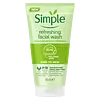What's inside
What's inside
 Key Ingredients
Key Ingredients

 Benefits
Benefits

 Concerns
Concerns

 Ingredients Side-by-side
Ingredients Side-by-side

Water
Skin ConditioningSodium C14-16 Olefin Sulfonate
CleansingCocamidopropyl Betaine
CleansingPropanediol
SolventSodium Cocoamphoacetate
CleansingSodium Cocoyl Isethionate
CleansingAcrylates/C10-30 Alkyl Acrylate Crosspolymer
Emulsion StabilisingGlycolic Acid
BufferingMyrciaria Dubia Fruit Extract
Skin ConditioningTerminalia Ferdinandiana Fruit Extract
AntioxidantSodium Lauroyl Sarcosinate
CleansingCeramide Ag
HumectantAlpha-Arbutin
Antioxidant3-O-Ethyl Ascorbic Acid
Skin ConditioningOryza Sativa Cera
Skin ConditioningNiacinamide
SmoothingParfum
MaskingPhenoxyethanol
PreservativePEG-7 Glyceryl Cocoate
EmulsifyingXanthan Gum
EmulsifyingCocamide Mea
EmulsifyingPhospholipids
Skin ConditioningSphingolipids
EmollientSodium Hydroxide
BufferingDisodium EDTA
Menthol
MaskingCI 19140
Cosmetic ColorantWater, Sodium C14-16 Olefin Sulfonate, Cocamidopropyl Betaine, Propanediol, Sodium Cocoamphoacetate, Sodium Cocoyl Isethionate, Acrylates/C10-30 Alkyl Acrylate Crosspolymer, Glycolic Acid, Myrciaria Dubia Fruit Extract, Terminalia Ferdinandiana Fruit Extract, Sodium Lauroyl Sarcosinate, Ceramide Ag, Alpha-Arbutin, 3-O-Ethyl Ascorbic Acid, Oryza Sativa Cera, Niacinamide, Parfum, Phenoxyethanol, PEG-7 Glyceryl Cocoate, Xanthan Gum, Cocamide Mea, Phospholipids, Sphingolipids, Sodium Hydroxide, Disodium EDTA, Menthol, CI 19140
 Reviews
Reviews

Ingredients Explained
These ingredients are found in both products.
Ingredients higher up in an ingredient list are typically present in a larger amount.
Cocamidopropyl Betaine is a fatty acid created by mixing similar compounds in coconut oil and dimethylaminopropylamine, a compound with two amino groups.
This ingredient is a surfactant and cleanser. It helps gather the dirt, pollutants, and other impurities in your skin to be washed away. It also helps thicken a product and make the texture more creamy.
Being created from coconut oil means Cocamidopropyl Betaine is hydrating for the skin.
While Cocamidopropyl Betaine was believed to be an allergen, a study from 2012 disproved this. It found two compounds in unpure Cocamidopropyl Betaine to be the irritants: aminoamide and 3-dimethylaminopropylamine. High-grade and pure Cocamidopropyl Betaine did not induce allergic reactions during this study.
Learn more about Cocamidopropyl BetaineDisodium EDTA plays a role in making products more stable by aiding other preservatives.
It is a chelating agent, meaning it neutralizes metal ions that may be found in a product.
Disodium EDTA is a salt of edetic acid and is found to be safe in cosmetic ingredients.
Learn more about Disodium EDTAPhenoxyethanol is a preservative that has germicide, antimicrobial, and aromatic properties. Studies show that phenoxyethanol can prevent microbial growth. By itself, it has a scent that is similar to that of a rose.
It's often used in formulations along with Caprylyl Glycol to preserve the shelf life of products.
Sodium Hydroxide is also known as lye or caustic soda. It is used to adjust the pH of products; many ingredients require a specific pH to be effective.
In small amounts, sodium hydroxide is considered safe to use. However, large amounts may cause chemical burns due to its high alkaline.
Your skin has a natural pH and acid mantle. This acid mantle helps prevent harmful bacteria from breaking through. The acid mantle also helps keep your skin hydrated.
"Alkaline" refers to a high pH level. A low pH level would be considered acidic.
Learn more about Sodium HydroxideWater. It's the most common cosmetic ingredient of all. You'll usually see it at the top of ingredient lists, meaning that it makes up the largest part of the product.
So why is it so popular? Water most often acts as a solvent - this means that it helps dissolve other ingredients into the formulation.
You'll also recognize water as that liquid we all need to stay alive. If you see this, drink a glass of water. Stay hydrated!
Learn more about Water